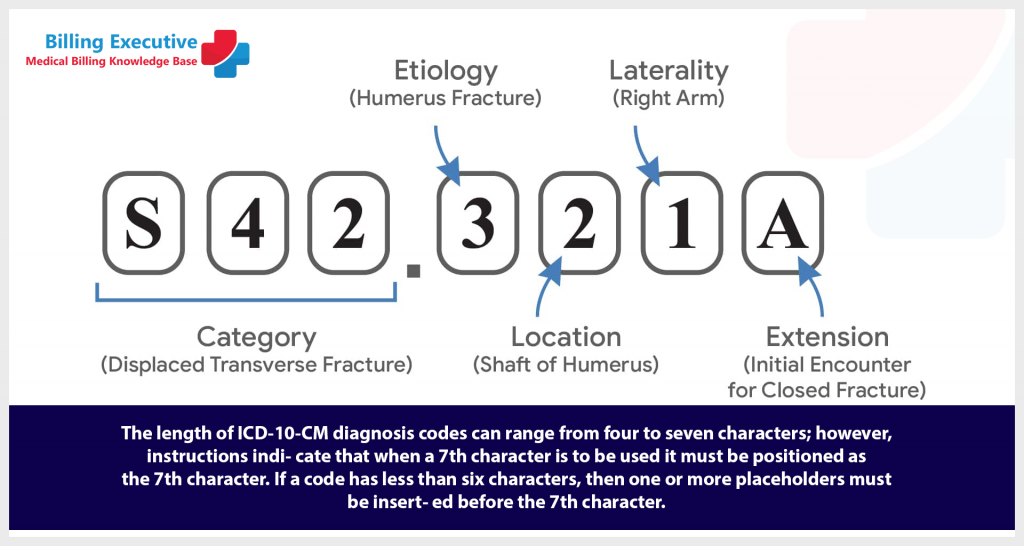In ICD-10, there are seven possible characters for filling out a code. The first three offer the diagnosis category. The second set of three corresponds to the diagnostic’ etiology, i.e., the cause and any further clarifying information. Then there’s the seventh Character. The seventh Character is an expansion generally used to mark episodes of care for injuries and other conditions caused by external factors.

The ICD-10 7th Character is only required when the ICD-10 regulations request it and provide you an option between many characters. A 7th character usually is only necessary in the case of injuries for PT/OT.
Common 7th characters
A, D, and S are the most common seventh characters. Because you virtually always give care during the healing or recovery phase of an injury as a therapist, you will employ the D character. More precisely, the following describes when each Character is used.
The following section explains when each Character is used.
Character A: This Character deals with the initial encounter that occurs when the patient is actively receiving therapy for the injury, poisoning, or other external cause-related consequences
For example: If the practitioner sends the patient to the emergency room, all three treating providers would code the injury with “A” Initial Encounter.
Character D: It is related to subsequent encounter, which is used during the healing phase following the active phase to check the patient is recuperating correctly. Most PT/OT, including your initial evaluation, is viewed as a subsequent encounter during a care episode. Utilize character D for the great majority of PT/OT care that requires a 7th character,
Character S: The seventh Character, S, discovers the source of the sequela. (Complications caused by a previous injury) For example: burn scar.
Alternative 7th Characters For Fracture Care
Fracture coding typically requires one of the following 7th characters as an alternative to these A, D, and S 7th characters; however, the ICD-10 tables or tool you are using should expressly ask for one of these characters.
Character A: The seventh Character, S, discovers the source of the initial encounter for closed fracture.
Character B: The seventh Character, S, discovers the source of the initial encounter with an open fracture.
Character D: The seventh Character S discovers the source of subsequent encounter for fracture with routine healing.
Character G: The seventh Character S discovers the source of subsequent encounter for fracture with delayed healing.
Character K: The seventh Character S discovers the source of subsequent encounter for fracture with non-union.
Character P: The seventh Character S discovers the source of subsequent encounter for fracture with mal union.
Character S: The seventh Character, S, discovers the source of sequela.
Proven Strategies for Mastering ICD-10 7th Characters
Following guidelines can help you improve your diagnosis coding abilities.
Don’t Ignore 7th Character Requirements.
If an ICD-10 code requires a seventh character, you must report a seven-character code. Payers will not accept incomplete codes. That is an apparent suggestion, but as Tips 2 and 3 prove that getting the 7th Character on your code isn’t always easy.
Understand When to Use Placeholder X
In several codes, ICD-10-CM employs the placeholder character X. This occurs when a code demands a later character in a particular position. Yet, the code lacks specific characters for one or more places before that Character. The ICD-10-CM code system allows for future expansion by utilizing a placeholder.
Search Consistently Your 7th Character
Many ICD-10-CM resources include the 7th character requirement and the alternatives for those characters at the category (three-character) level. There may be no indication at any subcategory levels that a 7th character is required.
Choose an ICD-10-CM resource that tells you of additional code needs at each level, if possible, so you don’t have to look for them. Easy access to 7th character standards reduces the risk of claim issues due to incomplete codes.
Get to Know Your Potential Options
The following three choices opt as the 7th Character
1. Character A (first encounter)
2. Character D (second encounter)
3. Character S (sequela)
Consult the Official Guidelines, For 7th Character Explanations
The explanations of the phrases used for the seventh characters are not obvious; however, reading the appropriate sections in the ICD-10-CM Official Guidelines can help you understand the purpose of these characters.
Add to Your Fracture Options
Traumatic fracture categories contain additional 7th character values, so don’t just stick to A, D, or S on the end of a fracture code and think you’re done.
About us
Billing Executive – a Medical Billing and Coding Knowledge Base for Physicians, Office staff, Medical Billers and Coders, including resources pertaining to HCPCS Codes, CPT Codes, ICD-10 billing codes, Modifiers, POS Codes, Revenue Codes, Billing Errors, Denials and Rejections.
We have more than 10 years experience in US Medical Billing and hand-on experience in Web Management, SEO, Content Marketing & Business Development with Research as a special forte.
Learn More:
A Comprehensive Guideline To ICD-10 Codes
A Comprehensive Guideline To Modifier 25
Denial CO 11: Diagnosis is inconsistent with The Procedure
CO12 Denial Code: Diagnosis is inconsistent with the Provider Type
